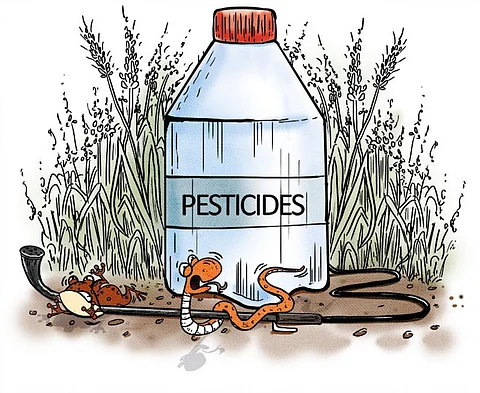

Illustration by Yogendra Anand / CSE
The demand for land for food production always results in an uncomfortable trade-off between agricultural expansion and species conservation. One can see an example of this trade-off in paddy fields, whose unique combination of wet and drylands provide ideal habitats for amphibians and reptiles. These cold-blooded animals, together referred to as herpetofauna, provide immense ecological services. Frogs and toads, for instance, act as biological control agents by feeding on crop pests. Several salamanders and tadpoles of frogs help in controlling mosquito and mosquito-borne diseases by feeding on the larvae. They also help improve soil quality and aeration, aid in dispersal of seeds and in pollination—there are almost 40 species of lizards including skinks and geckos that are efficient pollinators.
However, the diversity and abundance of these herpetofauna are rapidly declining with increased use of pesticides, fertilisers, land conversion, changes in cropping systems and the reduced proportion of natural vegetation. According to the International Union for Conservation of Nature (IUCN), 1,532 species of Anurans (frogs) and 825 species of reptiles in the world are critically endangered, endangered and vulnerable due to agriculture and its management practices. They appear to be particularly threatened in India which has a high amphibian diversity—most of them are endemic to the region—and, as per the UN Food and Agriculture Organization, had the largest cropland area over the last decade, followed by the US and China. To understand the impact of crop intensification on the populations and diversity of herpetofauna, researchers from the University of Calcutta conducted a year-long survey of farm lands in Odisha’s Baleswar district, known as rice bowl of the state. Almost 90 per cent of the 250,550 hectares of cultivable land in the district is under paddy, according to data available on the district’s official website.
Being cold-blooded, amphibians and reptiles have unique physiological demands. They are extremely sensitive to microclimates (with a narrow range of soil humidity, moisture, light flux, acidity, air and soil temperature) and microhabitats (they have small habitats like grass cover and low dispersal range; maximum lifetime dispersal for frogs and toads is 12 km). This makes them particularly susceptible to agricultural intensification. However, the researchers find a distinct difference in the way it affects amphibians and reptiles.
The abundance of amphibians was almost half and their diversity was low in areas with high cropping intensity, pesticide application and low natural vegetation when compared with areas where less-intensive farming is practised. This difference is because amphibians are more exposed to pesticide contamination than reptiles as their skin is highly permeable and performs both respiration and water uptake, the researchers say in a 2020 study published in the journal Biotropica. The consequences could be far reaching as waterbodies, which harbour amphibians at various stages of their life, can get contaminated by pesticides due to seepage and spillover from agricultural lands even if they are 1 km away. By comparison, reptiles only inhale and ingest the pesticide. Their home range is also larger compared to an amphibian.
But this does not mean all is well with reptiles. The researchers suggest the species are rather going through an “extinction debt” wherein there is a lag between the impact of agricultural intensification on them and their response to it. The real impact of the current intensification of agriculture on reptiles would be felt much later. When compared with amphibians, reptiles like snakes face a higher threat from conflicts with humans. Encroachment of forest areas and misconceptions and myths result in the indiscriminate killing of snakes irrespective of them being venomous or harmless.
The researchers also find that in areas where the diversity of the frog population is lesser, the numbers of beneficial arthropods have reduced due to intraguild predation—a phenomenon where more than one species feed on the same prey and therefore competitors feed on each other. If this reduction in populations of both predators continues, it will disrupt the natural system of suppressing crop pest abundance, the researchers conclude in another study, which is yet to undergo peer review and currently available as a preprint in online repository BioRxiv. The study shows unless a threshold abundance of frogs is maintained, their impacts will be far from beneficial to agriculture.
Natural enemies of insect pests are responsible for an estimated 50-90 per cent of biological pest control in crop fields and economically this function has been estimated to be worth US $400 billion worldwide, according to a 2006 study by US researchers in the journal Agriculture, Ecosystems & Environment. The studies show that this can be facilitated by introducing diversity in habitats such as the presence of forested areas and hedgerows on the peripheries of fields, along with a reduction in monoculture or intensive crop cultivation.
Semi-natural and natural vegetation and buffer strips such as ditches, provide chances to increase numbers of alternate prey, intermediate hosts of target pests and increase the availability of nutritional plant resources. Semi-natural patches are beneficial for arthropod communities and can raise their numbers to enhance crop pest regulation. To optimise the benefits from existing farmland, the researchers recommend that biodiversity research be holistic so more organisms get targeted ecological services.
(Deyatima Ghosh is visiting researcher at University of Lincoln, UK and postdoctoral researcher at Ashoka Trust for Research in Ecology and the Environment, Bengaluru)
This was first published in the 1-15 January, 2023 print edition of Down To Earth